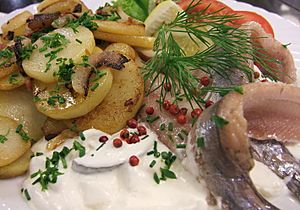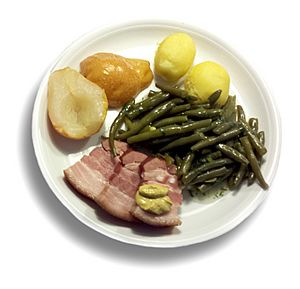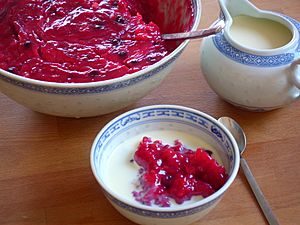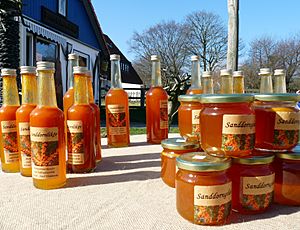Pomeranian cuisine facts for kids

Pomeranian cuisine refers to the traditional foods from the historic Pomerania region in northeast Germany. This area included cities like Stettin (now Szczecin). The food here is known for using fresh ingredients from local farms.
Pomeranian dishes often feature ingredients like swede (called Wruken) and sugar beet. Poultry farming is also important, especially for the famous Pomeranian goose. Because Pomerania is close to the Baltic Sea and has many rivers and lakes, fish is a big part of the diet. Forests also provide wild game.
Pomeranian food is usually hearty and filling. Potatoes, known as Tüften, are very important and are cooked in many ways. There's even a West Pomeranian Potato Museum! Other key ingredients include Grünkohl (kale) and sweet and sour dishes, often made by baking fruit.
Historically, Pomeranian farmers grew most of their own food. They stored crops for the winter and preserved meats by smoking them. Fruits, vegetables, and fats like lard were kept in jars. They even made their own syrup from sugar beet.
Contents
Tasty Pomeranian Dishes
Pomeranian cuisine has many unique and delicious dishes. Here are some of the most well-known ones:
Soups
- Gänseschwarzsauer (a rich goose soup)
- Kliebensuppe (a type of dumpling soup)
- Pomeranian duck soup (Pommersche Entensuppe)
Fish Dishes
Fish is a big part of Pomeranian meals, thanks to the nearby sea and lakes.
- Gebackener Spickaal (baked, smoked eel)
- Braden Maischull (fried plaice)
- Pomeranian caviar (Pommerscher Kaviar)
Pork and Beef Meals
Meat dishes are also very popular and filling.
- Kloppschinken (a type of ham)
- Topfleberwurst (a liver sausage)
- Mecklenburg roast ribs (Mecklenburger Rippenbraten)
Stews, Vegetables, and Potatoes

Potatoes are a staple, and many dishes combine them with other local ingredients.
- Tüffel un Plum (potato soup with plums and bacon)
- Buttermilk soup with bacon and onions in the Pomeranian style (Buttermilchsuppe mit Speck und Zwiebeln auf pommersche Art)
- Elderberry soup (Fliederbeersuppe)
- Pomeranian wheat blintzes (Pommersche Hefeplinsen)
- Pomeranian dumplings (Pommersche Klöße)
- Pomeranian Tollatsch (Pommersche Tollatschen)
- Schwemmklöße (floating dumplings)
- Buttermilk potatoes (Buttermilchkartoffel)
- Birnen, Bohnen und Speck (pears, beans, and bacon)
Sweet Puddings

For dessert, Pomerania offers several sweet treats.
- Black bread pudding (Schwarzbrotpudding)
- Götterspeise (a jelly-like dessert)
- Rote Grütze (a red berry pudding)
- Mandelkringel (an almond pastry)
- Sour cream cake (Schmandpudding)
Christmas Treats
During the Christmas season, special baked goods are enjoyed.
- Honigkuchen auf dem Blech (honey cake)
- Kleine pommersche Kuchen (small Pomeranian cakes)
- Pommersche Honigbutterküchlein (honey butter cookies)
- Pommersche Quarkbollerchen (quark pastries)
- White Pfeffernüsse (a type of spiced cookie)
Drinks

Pomerania also has its own traditional drinks.
- Grog (a warm alcoholic drink, often with rum)
- Sea buckthorn (Sanddorn): This berry is used to make fruit wine, spirits, and juice.
Local Beers
Pomerania is home to several breweries that make different kinds of beer. You can find various types like Pils, Amber ale, wheat beer, and even fruit beers. Some famous breweries are in Barth, Mellenthin on the island of Usedom, and Stralsund.
Famous Restaurants
Pomerania has many excellent restaurants, and some have even won awards for their amazing food. Chefs in places like Binz on the island of Rügen, Stolpe (Peene), Heringsdorf on Usedom, and Stralsund create delicious meals that are highly praised by food critics. These restaurants often use fresh, local ingredients to make their dishes special.
Books About Pomeranian Food
Many books have been written about Pomeranian cuisine, sharing traditional recipes and stories. These books help keep the region's food traditions alive.
See also
 In Spanish: Gastronomía de Mecklemburgo-Pomerania Occidental para niños
In Spanish: Gastronomía de Mecklemburgo-Pomerania Occidental para niños

